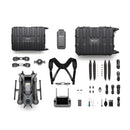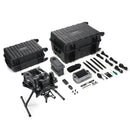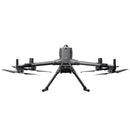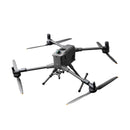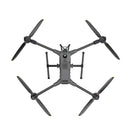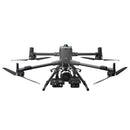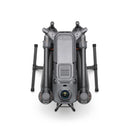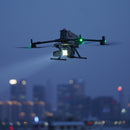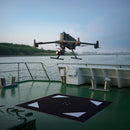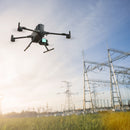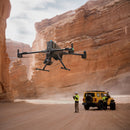DJI’s Matrice 400 delivers 59-minute endurance, 6 kg multi-sensor capacity, IP55 weatherproofing, LiDAR/mmWave obstacle sensing, 40 km O4 HD link and hot-swap TB100 power—an enterprise UAV engineered for power-line, public-safety, mapping and offshore missions demanding longer range, heavier payloads and all-weather reliability.
|
|
|
|
|
|
|
|
DJI Matrice 400 — engineered for excellence, designed for unmatched versatility. DJI’s newest enterprise flagship stretches flight endurance, payload flexibility, and situational awareness further than any Matrice to date. With a class-leading 59-minute forward-flight time, a 13.2 lb / 6 kg maximum payload, and a triple-layer obstacle-sensing suite that pairs rotating LiDAR with mmWave radar and full-color low-light vision, the M400 empowers power-grid engineers, search-and-rescue crews, surveyors, and AEC professionals to cover more ground in fewer flights—day or night, rain or shine.

Extended Flight Time & High-Speed Performance
- Fly Longer — 59 min forward flight / 53 min hover* keeps wildfire overwatch, wide-area SAR, and long-corridor mapping missions on a single battery set.
- Arrive faster — 25 m/s (≈ 56 mph) max cruise slashes transit legs while the obstacle-sensing array actively scans for buildings, towers, and terrain.
- TB100 Intelligent Flight Batteries deliver up to 400 charge cycles, self-heat below 50 °F (10 °C), and recharge to 100 % in just 45 min** inside the BS100 station.
Multi-Payload, Multi-Scene Versatility

Four E-Port V2 interfaces, dual downward gimbals, and a third underslung gimbal connector let the M400 fly up to seven simultaneous payloads. Seamlessly switch between single - or dual-gimbal set-ups to suit the assignment.
Compatible Payloads:
- Zenmuse H30 Series — 5-in-1 sensor block (wide, zoom, thermal, LRF, NIR) shattering day-to-night ISR limits.
- Zenmuse L2 LiDAR — 240 k pts/s frame-based LiDAR + 4/3 ″ RGB for centimeter-grade point clouds.
- Zenmuse P1 Photogrammetry — full-frame, 45-MP stills at 0.7 s intervals with 24 / 35 / 50 mm lenses.
- Zenmuse S1 Spotlight & Zenmuse V1 Speaker — 32 W LEP long-throw lighting and 114 dB PA for night SAR, crowd comms, and tactical ops.
- Manifold 3 — 100 TOPS NVIDIA® processing unlocks onboard AI models and advanced autonomy.
*Payloads sold separately.
Flight Time
Estimate the Matrice 400’s flight time based on your payload configuration.

Safe and Reliable Flight
Built for Challenging Conditions
Rated IP55, the Matrice 400 performs dependably in harsh environments, shrugging off heavy dust and rain. Designed for temperature extremes, it delivers consistent performance from –20 °C to 50 °C (–4 °F to 122 °F), ensuring reliable results in both frigid and scorching conditions.
Power-Line-Level Obstacle Sensing
An integrated rotating LiDAR + mmWave radar + full-color low-light vision system detects obstacles as small as 0.85 in / 21.6 mm conductors at speeds up to 56 mph—even in fog, rain, or total darkness. Six fisheye cameras switch to black-and-white below 12 lux for enhanced contrast, while GNSS + Vision Fusion maintains precise positioning in GPS-denied canyons, under bridges, and alongside glass-curtain facades.
Robust Video Transmission & Airborne Relay
- O4 Enterprise Enhanced streams 1080p / 60 fps up to 24.9 mi / 40 km (FCC) line-of-sight.
- Sub-2 GHz fallback & dual 4G DJI Cellular Dongle 2 keep the downlink alive in RF-dense metros and remote valleys.
- Airborne Relay mode turns a high-hover M400 into a skyborne repeater, extending C2 links for a second drone beyond ridgelines or deep inside urban canyons.
Aircraft Fusion Positioning & Full-Color Vision Assist
Rotating LiDAR, radar, and fisheye vision fuse with dual-band GNSS to create centimeter-class positional accuracy—even when primary satellites fade. Four full-color fisheye sensors feed Full-Color Vision Assist, overlaying a pilot-eye view on the controller to reveal blind-spot hazards during complex maneuvers.
Enhanced Intelligence & Operational Efficiency
Smart Detection
Paired with the H30 Series, onboard AI auto-labels vehicles, vessels, and people across visible and thermal feeds, pushing real-time metadata to FlightHub 2 for team-wide situational awareness.
Smart AR Projection
- Power-Line AR highlights conductors as bold on-screen vectors, slashing pilot workload in lattice corridors.
- Map View AR labels buildings, landmarks, and core roadways in real time—day or night.
- AR Waypoint & Landing Shadow previews RTH routes and projects an on-ground aircraft shadow to nail pinpoint touchdowns.
Real-Time Terrain Follow
Maintains constant AGL in any horizontal direction—perfect for slope mapping, forest SAR, or uniform-GSD photogrammetry.
Takeoff & Landing on Ships
Pattern-recognition landing detects deck markers and lands safely on vessels moving ≤ 10 knots (11.5 mph). Critical for coastal patrol and offshore turbine inspection.
Intelligent Flight Modes
- Cruise — lock heading and speed for mile-long linear surveys without thumb fatigue.
- FlyTo — single-tap rerouting with obstacle-aware path planning to the clicked waypoint.
- Smart Track — auto-zoom, subject re-acquisition, and hands-off orbiting for persistent target coverage.
- POI — automated 360° orbits and 3D modeling of assets such as stacks, spires, or cell towers.
Easier Automated Operations
The M400 natively supports DJI Pilot 2 quick-task templates, slope and geometric route planners in FlightHub 2, and power-line follow missions when paired with the Zenmuse L2 LiDAR. Onboard compute continuously analyzes LiDAR returns to auto-sidestep crossing conductors during energized-line patrols.
Comprehensive Accessory Upgrades
- DJI RC Plus 2 Enterprise Enhanced — 7.02 ″, 1400-nit touch screen, IP54, and sub-2 GHz ready.
- BS100 Battery Station — charges three TB100 packs to 100% in 45 min or maintains 90% “Ready-to-Fly” SOC with a whisper-quiet 36 dB Silent Mode.
- D-RTK 3 Multifunctional Station — base, rover, or relay; centimeter-level PPK/RTK support for multiple drones simultaneously.
- TB100C Tethered Battery — taps third-party cabled systems for round-the-clock aerial lighting or LTE mesh comms.
Software Stack for Vertical Workflows
- DJI FlightHub 2 — cloud-based fleet management, live multi-feed display, and remote flight control when regulations allow.
- DJI Terra — rapid 2D/3D reconstruction from RGB or LiDAR; integrates seamlessly with L2 point-cloud pipelines.
- DJI Modify — AI-assisted mesh and point-cloud cleanup for turnkey BIM, volumetric, and as-built deliverables.
Open Developer Ecosystem
- Intelligent Algorithm Developer Suite lets data scientists train models, push them to Manifold 3, and certify them for the DJI store.
- PSDK 2.0 — up to 120 W per port, USB 3.0 bandwidth, and an E-Port Hub that fans one port into four.
- MSDK 5 — open-source templates derived from DJI Pilot 2 shorten time-to-market for custom mobile apps.
- Cloud API — MQTT-based, zero-app integration pipes telemetry and live video directly into third-party dashboards.
- Open Sensor & Data Feeds expose raw LiDAR, radar, and vision packets for bespoke analytics.
* Flight time measured at sea level, 10 m/s constant speed, no wind, H30T payload. **Charging time measured at 220 V. All figures are for reference; real-world performance varies with altitude, temperature, payload, and local regulations. Always fly safely and in accordance with applicable laws.
DJI Matrice 400 — engineered for excellence, designed for unmatched versatility. DJI’s newest enterprise flagship stretches flight endurance, payload flexibility, and situational awareness further than any Matrice to date. With a class-leading 59-minute forward-flight time, a 13.2 lb / 6 kg maximum payload, and a triple-layer obstacle-sensing suite that pairs rotating LiDAR with mmWave radar and full-color low-light vision, the M400 empowers power-grid engineers, search-and-rescue crews, surveyors, and AEC professionals to cover more ground in fewer flights—day or night, rain or shine.

Extended Flight Time & High-Speed Performance
- Fly Longer — 59 min forward flight / 53 min hover* keeps wildfire overwatch, wide-area SAR, and long-corridor mapping missions on a single battery set.
- Arrive faster — 25 m/s (≈ 56 mph) max cruise slashes transit legs while the obstacle-sensing array actively scans for buildings, towers, and terrain.
- TB100 Intelligent Flight Batteries deliver up to 400 charge cycles, self-heat below 50 °F (10 °C), and recharge to 100 % in just 45 min** inside the BS100 station.
Multi-Payload, Multi-Scene Versatility

Four E-Port V2 interfaces, dual downward gimbals, and a third underslung gimbal connector let the M400 fly up to seven simultaneous payloads. Seamlessly switch between single - or dual-gimbal set-ups to suit the assignment.
Compatible Payloads:
- Zenmuse H30 Series — 5-in-1 sensor block (wide, zoom, thermal, LRF, NIR) shattering day-to-night ISR limits.
- Zenmuse L2 LiDAR — 240 k pts/s frame-based LiDAR + 4/3 ″ RGB for centimeter-grade point clouds.
- Zenmuse P1 Photogrammetry — full-frame, 45-MP stills at 0.7 s intervals with 24 / 35 / 50 mm lenses.
- Zenmuse S1 Spotlight & Zenmuse V1 Speaker — 32 W LEP long-throw lighting and 114 dB PA for night SAR, crowd comms, and tactical ops.
- Manifold 3 — 100 TOPS NVIDIA® processing unlocks onboard AI models and advanced autonomy.
*Payloads sold separately.
Flight Time
Estimate the Matrice 400’s flight time based on your payload configuration.

Safe and Reliable Flight
Built for Challenging Conditions
Rated IP55, the Matrice 400 performs dependably in harsh environments, shrugging off heavy dust and rain. Designed for temperature extremes, it delivers consistent performance from –20 °C to 50 °C (–4 °F to 122 °F), ensuring reliable results in both frigid and scorching conditions.
Power-Line-Level Obstacle Sensing
An integrated rotating LiDAR + mmWave radar + full-color low-light vision system detects obstacles as small as 0.85 in / 21.6 mm conductors at speeds up to 56 mph—even in fog, rain, or total darkness. Six fisheye cameras switch to black-and-white below 12 lux for enhanced contrast, while GNSS + Vision Fusion maintains precise positioning in GPS-denied canyons, under bridges, and alongside glass-curtain facades.
Robust Video Transmission & Airborne Relay
- O4 Enterprise Enhanced streams 1080p / 60 fps up to 24.9 mi / 40 km (FCC) line-of-sight.
- Sub-2 GHz fallback & dual 4G DJI Cellular Dongle 2 keep the downlink alive in RF-dense metros and remote valleys.
- Airborne Relay mode turns a high-hover M400 into a skyborne repeater, extending C2 links for a second drone beyond ridgelines or deep inside urban canyons.
Aircraft Fusion Positioning & Full-Color Vision Assist
Rotating LiDAR, radar, and fisheye vision fuse with dual-band GNSS to create centimeter-class positional accuracy—even when primary satellites fade. Four full-color fisheye sensors feed Full-Color Vision Assist, overlaying a pilot-eye view on the controller to reveal blind-spot hazards during complex maneuvers.
Enhanced Intelligence & Operational Efficiency
Smart Detection
Paired with the H30 Series, onboard AI auto-labels vehicles, vessels, and people across visible and thermal feeds, pushing real-time metadata to FlightHub 2 for team-wide situational awareness.
Smart AR Projection
- Power-Line AR highlights conductors as bold on-screen vectors, slashing pilot workload in lattice corridors.
- Map View AR labels buildings, landmarks, and core roadways in real time—day or night.
- AR Waypoint & Landing Shadow previews RTH routes and projects an on-ground aircraft shadow to nail pinpoint touchdowns.
Real-Time Terrain Follow
Maintains constant AGL in any horizontal direction—perfect for slope mapping, forest SAR, or uniform-GSD photogrammetry.
Takeoff & Landing on Ships
Pattern-recognition landing detects deck markers and lands safely on vessels moving ≤ 10 knots (11.5 mph). Critical for coastal patrol and offshore turbine inspection.
Intelligent Flight Modes
- Cruise — lock heading and speed for mile-long linear surveys without thumb fatigue.
- FlyTo — single-tap rerouting with obstacle-aware path planning to the clicked waypoint.
- Smart Track — auto-zoom, subject re-acquisition, and hands-off orbiting for persistent target coverage.
- POI — automated 360° orbits and 3D modeling of assets such as stacks, spires, or cell towers.
Easier Automated Operations
The M400 natively supports DJI Pilot 2 quick-task templates, slope and geometric route planners in FlightHub 2, and power-line follow missions when paired with the Zenmuse L2 LiDAR. Onboard compute continuously analyzes LiDAR returns to auto-sidestep crossing conductors during energized-line patrols.
Comprehensive Accessory Upgrades
- DJI RC Plus 2 Enterprise Enhanced — 7.02 ″, 1400-nit touch screen, IP54, and sub-2 GHz ready.
- BS100 Battery Station — charges three TB100 packs to 100% in 45 min or maintains 90% “Ready-to-Fly” SOC with a whisper-quiet 36 dB Silent Mode.
- D-RTK 3 Multifunctional Station — base, rover, or relay; centimeter-level PPK/RTK support for multiple drones simultaneously.
- TB100C Tethered Battery — taps third-party cabled systems for round-the-clock aerial lighting or LTE mesh comms.
Software Stack for Vertical Workflows
- DJI FlightHub 2 — cloud-based fleet management, live multi-feed display, and remote flight control when regulations allow.
- DJI Terra — rapid 2D/3D reconstruction from RGB or LiDAR; integrates seamlessly with L2 point-cloud pipelines.
- DJI Modify — AI-assisted mesh and point-cloud cleanup for turnkey BIM, volumetric, and as-built deliverables.
Open Developer Ecosystem
- Intelligent Algorithm Developer Suite lets data scientists train models, push them to Manifold 3, and certify them for the DJI store.
- PSDK 2.0 — up to 120 W per port, USB 3.0 bandwidth, and an E-Port Hub that fans one port into four.
- MSDK 5 — open-source templates derived from DJI Pilot 2 shorten time-to-market for custom mobile apps.
- Cloud API — MQTT-based, zero-app integration pipes telemetry and live video directly into third-party dashboards.
- Open Sensor & Data Feeds expose raw LiDAR, radar, and vision packets for bespoke analytics.
* Flight time measured at sea level, 10 m/s constant speed, no wind, H30T payload. **Charging time measured at 220 V. All figures are for reference; real-world performance varies with altitude, temperature, payload, and local regulations. Always fly safely and in accordance with applicable laws.
DJI Matrice 400 Specifications
Aircraft
| Takeoff Weight (with propellers) | Without Batteries: 5020 ± 20 g With Batteries: 9740 ± 40 g The actual product weight may vary due to differences in batch materials and external factors. |
| Max Takeoff Weight | 15.8 kg |
| Dimensions | Unfolded: 980 × 760 × 480 mm (L × W × H) with landing gear Folded: 490 × 490 × 480 mm (L × W × H) with landing gear & gimbal Maximum dimensions exclude propellers. Carrying-case: 779 × 363 × 528 mm |
| Max Payload | 6 kg Measured at the third-gimbal connector under sea-level conditions; capacity decreases with altitude. |
| Propeller Size | 25 inches (model 2510F) |
| Diagonal Wheelbase | 1070 mm |
| Max Ascent Speed | 10 m/s |
| Max Descent Speed | 8 m/s |
| Max Horizontal Speed (sea level, no wind) | 25 m/s |
| Max Takeoff Altitude | 7000 m |
| Max Flight Time (no wind) | 59 min 10 m/s forward flight, H30T payload, sea level. |
| Max Hover Time (no wind) | 53 min Hover test, H30T payload, sea level. |
| Max Flight Distance (no wind) | 49 km 17 m/s cruise, no external payload. |
| Max Wind Resistance | 12 m/s (during takeoff / landing) |
| Max Yaw Angular Velocity | 100 °/s |
| Max Pitch Angle | 35 ° |
| Operating Temperature | -20 ° – 50 °C (-4 ° – 122 °F) (no solar radiation) |
| GNSS | GPS + Galileo + BeiDou + GLONASS* * GLONASS active only with RTK module. |
| Hovering Accuracy (no / moderate wind) | Vertical: ±0.1 m (vision), ±0.5 m (GNSS), ±0.1 m (RTK) Horizontal: ±0.3 m (vision), ±0.5 m (GNSS), ±0.1 m (RTK) |
| RTK GNSS Accuracy | 1 cm + 1 ppm (H), 1.5 cm + 1 ppm (V) |
| RTK Heading | < 2 ° |
| ADS-B In | Integrated receiver, dual antennas, up to 20 km reception |
| Internal Storage | N/A |
| I/O Ports | USB-C debug × 1 (USB 2.0) E-Port V2 × 4 (120 W each) Cellular Dongle 2 × 2 |
| Beacon | Built-in |
| Ingress Protection | IP55 Rating may degrade with wear. |
Gimbal
| Max Payload – Single Connector | 1400 g If payload > 950 g, damper life decreases from 1000 h to 400 h. |
| Max Payload – Dual Connector | 950 g |
| Max Payload – Third Connector | 3 kg (quick-release) / 6 kg (screw-lock) |
Sensing
| Sensing Type | 360° binocular vision + rotating LiDAR, upper LiDAR, downward 3D IR, six-direction mmWave radar; surround-view full-color fisheye cameras |
| Forward / Backward | Measure 0.4 – 21 m | Detect 0.4 – 200 m | FOV 90° × 90° |
| Lateral | Measure 0.6 – 21 m | Detect 0.5 – 200 m | FOV 90° × 90° |
| Downward | Measure 0.5 – 19 m | FOV 160° (front/back), 105° (left/right) |
| Operating Environment | Surfaces with clear texture & light (horizontal); diffuse-reflective ground > 20 % reflectivity (downward) * Nighttime city-light or brighter. |
| Rotating LiDAR | 0.5 – 100 m @ 10 % reflectivity (100 klx) 520 k pts/s | FOV 360° × 58° 905 nm Class-1 laser | wire detection 35 m @ 30° |
| Upper LiDAR (3D ToF) | 0.5 – 25 m at night (reflectivity > 10 %) | FOV 60° × 60° |
| Downward 3D IR Sensor | 0.3 – 8 m (reflectivity > 10 %) | FOV 60° × 60° |
| mmWave Radar | Power-line detect: 36 m (12.5 mm) / 50 m (21.6 mm) FOV ±45° (h/v) Unavailable in some regions. |
FPV Camera
| Resolution | 1080p |
| Field of View | DFOV 150° | HFOV 139.6° | VFOV 95.3° |
| Frame Rate | 30 fps |
| Night Vision | Starlight-grade |
Video Transmission
| System | DJI O4 Enterprise Enhanced |
| Live View Quality | 3-channel 1080p / 30 fps (RC) |
| Operating Frequency & EIRP | 902-928 MHz: < 30 dBm (FCC) | < 16 dBm (MIC) 1.430-1.444 GHz: < 35 dBm (SRRC) 2.400-2.4835 GHz: < 33 dBm (FCC) | < 20 dBm (CE/SRRC/MIC) 5.150-5.250 GHz: < 23 dBm (FCC/CE) 5.725-5.850 GHz: < 33 dBm (FCC) | < 14 dBm (CE) | < 30 dBm (SRRC) Bands vary by region; always follow local regulations. |
| Max Range (LOS, no interference) | 40 km (FCC) / 20 km (CE/SRRC/MIC) |
| Max Range (with interference) | Dense urban: ≈ 1.5 – 6 km Suburban: ≈ 6 – 15 km Open areas: ≈ 15 – 40 km |
| Max Download Speed | 80 Mbps real-time downlink | ≤ 25 MB/s playback |
| Antenna Array | WLAN × 8 (6 V + 2 H), sub-2 G × 2, 4G × 4 | 2T4R |
| Other Features | Dual-control mode | Dual DJI Cellular Dongle 2 support |
Battery
| Model | TB100 Intelligent Flight Battery |
| Capacity | 20,254 mAh |
| Standard Voltage | 48.23 V |
| Max Charging Voltage | 54.6 V |
| Cell Type | Li-ion 13S |
| Energy | 977 Wh |
| Weight | 4720 ± 20 g |
| Operating Temp | -20 ° – 75 °C (-4 ° – 122 °F) |
| Charging Temp | 5 ° – 45 °C (41 ° – 113 °F) |
| Heating Functions | Supports onboard & station self-heating |
| Discharge Rate / Charge Power | 4C max discharge | 2C max charge |
| Cycle Life | ≈ 400 cycles |
Intelligent Battery Station (BS100)
| Net Weight | 11.8 kg |
| Dimensions | 605 × 410 × 250 mm |
| Supported Batteries | TB100 / TB100C | WB37 |
| Operating Temperature | -20 ° – 40 °C (-4 ° – 104 °F) |
| Input | 100 – 240 V AC, 50 / 60 Hz, 10 A |
| Output | TB100 slots: 1185 – 2184 W (voltage-dependent) WB37 slots: ≈ 52 W USB-C: 5 V 3 A / 9 V 3 A / 12 V 3 A / 15 V 3 A / 20 V 3.25 A |
| Charging Channels | 3 × TB100 | 2 × WB37 (sequential) |
| Charging Modes | Ready-to-Fly 90 % | Standard 100 % | Fast & Silent modes |
| Charging Time* | TB100/TB100C 0 – 100 %: 45 min (220 V, Fast) | 70 min (110 V, Fast) 110 min (Silent mode) |
DJI RC Plus 2 Enterprise Enhanced
| Video Transmission System | DJI O4 Enterprise Enhanced |
| Max Range (LOS, no interference) | 40 km (FCC) / 20 km (CE/SRRC/MIC) |
| Operating Freq & EIRP | 902-928 MHz: < 30 dBm (FCC) | < 16 dBm (MIC) 1.430-1.444 GHz: < 35 dBm (SRRC) 2.400-2.4835 GHz: < 33 dBm (FCC) | < 20 dBm (CE/SRRC/MIC) 5.150-5.250 GHz: < 23 dBm (FCC/CE) 5.725-5.850 GHz: < 33 dBm (FCC) | < 14 dBm (CE) | < 30 dBm (SRRC) |
| Antenna Array | 2T4R multi-beam high-gain + sub-2 G 2T2R |
| Enhanced Transmission | Supports dual DJI Cellular Dongle 2 |
| Wi-Fi | 802.11 a/b/g/n/ac/ax | 2 × 2 MIMO | DBS dual-band simultaneous up to 1774 Mbps |
| Bluetooth | BT 5.2 | < 10 dBm EIRP |
| Display | 7.02″ 1920 × 1200 @ 60 fps | 1400 nits | 10-point multi-touch |
| Power | Internal 6500 mAh (46.8 Wh) | Optional WB37 4920 mAh (37 Wh) external |
| Charging Type | USB-C PD 20 V / 3.25 A |
| Runtime | 3.8 h (internal) | 3.2 h (internal + external) |
| Charging Time | ≈ 2 h (internal or internal + external, powered off) |
| I/O Ports | HDMI 1.4 | SD 3.0 | USB-C (OTG & 65 W PD) | USB-A 2.0 |
| Operating Temp | -20 ° – 50 °C (-4 ° – 122 °F) |
| Dimensions / Weight | 268 × 163 × 94.5 mm (antennas folded) | 1.15 kg (w/o external battery) |
| System / Model | Android 11 | TKPL 2 |
| Accessories | Neck-strap / waist-support (optional) |
Compatibility
| DJI Products Compatible with Matrice 400 |
Gimbals: Zenmuse H30 / H30T / L2 / P1 Accessories: Zenmuse S1 (spotlight), Zenmuse V1 (speaker), Manifold 3, RC Plus 2 sub-2 G SDR, DJI Cellular Dongle 2 RTK: D-RTK 3 Multifunctional Station, D-RTK 2 Mobile Station Ecosystem: DJI X-Port, E-Port V2 Development & Coax Kits, SkyPort V3 Adapter & Coax Kits |
(1) Matrice 400 Aircraft (with propeller holder)
(1) TB100 Intelligent Flight Battery
(1) BS100 Intelligent Battery Station
(1) Remote Controller — DJI RC Plus 2 Enterprise Enhanced
(1) WB37 Battery (for RC)
(1) Carrying Case
(2) Landing Gear
(2) Propeller Pair
(6) Propeller Washers and Screws
(1) Remote Controller Strap & Bracket
(1) USB-C ↔ USB-C Cable
(1) Power Cable
(4) Gimbal Damper
(1) Screws & Tools Set
(1) Cleaning Tools Set
(1) Rubber Port Covers & Screws Set
This is DJI Matrice 400
What is the ingress protection (IP) rating of DJI Matrice 400? Can I fly the drone in the rain?
It is IP55 rated. Do not fly in rain heavier than 100 mm / 24 h.
The IP rating is not permanently effective and may decrease due to product wear and tear.
What does the sensing system of DJI Matrice 400 consist of?
Omnidirectional binocular vision system
Downward-facing binocular vision system
LiDAR (horizontal rotating + upward)
Downward 3-D infrared range sensor
Six-directional mmWave radar
How is the obstacle-avoidance capability of DJI Matrice 400?
Power-line sensing:
Facing a main line (21.6 mm steel-core wire) — obstacle sensing supported up to 25 m/s.
Facing both main (21.6 mm) and distribution (12 mm) lines — obstacle sensing supported up to 17 m/s.
Performance varies with clouds, fog, rain, snow, object material, and shape. The aircraft cannot actively avoid fast-moving objects; fly with caution. The mmWave radar function is unavailable in some countries/regions.
How is the payload capacity of DJI Matrice 400?
The third gimbal connector supports up to 6 kg. When using the single downward gimbal, dual downward gimbals, and third connector together, the combined weight of non-DJI payloads must not exceed 6 kg. Contact the payload manufacturer for a test report to ensure safe flight under low-battery conditions.
Does DJI Matrice 400 use dual batteries or a single battery?
Single battery.
What is the certification level of DJI Matrice 400 in Europe?
DJI Matrice 400 is C3 certified by the European Union Aviation Safety Agency (EASA).
How do I activate DJI Matrice 400?
With DJI RC Plus 2 Enterprise Enhanced, connect to the internet via Wi-Fi or phone hotspot, then follow on-screen prompts to activate. After RC activation, connect the RC to the aircraft in DJI Pilot 2 and follow the prompts to activate the drone.
Without a 4 G dongle, how can I use Network RTK services with DJI Matrice 400?
Connect the remote controller to Wi-Fi and access Network RTK via the controller.
Are Network RTK services bound to the remote controller or the aircraft?
They are bound to the remote controller.
Does DJI Matrice 400 support quick start?
Yes. A built-in capacitor powers key components during battery swaps; if replacement finishes within 45 s, the aircraft resumes operation immediately.
Which payloads and accessories are compatible with DJI Matrice 400?
Gimbals: Zenmuse H30, H30T, L2, P1
Functional accessories: Zenmuse S1 Spotlight, Zenmuse V1 Speaker, Manifold 3, DJI RC Plus 2 sub-2 G SDR Module*, DJI Cellular Dongle 2
RTK: D-RTK 3 Multifunctional Station, D-RTK 2 Mobile Station
Ecosystem: DJI X-Port, E-Port V2 Dev & Coax Kits, SkyPort V3 Adapter & Coax Kits
* Operating frequencies vary by region; follow local regulations.
Can I install an upward gimbal connector on DJI Matrice 400?
No.
What mounting options does DJI Matrice 400 support?
Single downward, dual downward, and third gimbal connectors.
How many payload ports does DJI Matrice 400 have?
Four external E-Port V2 ports. The E4 port can expand to four via the E-Port HUB, allowing up to seven payloads.
Does DJI Matrice 400 have high-altitude propellers?
No; the standard 2510F propellers support flights up to 7 000 m ASL.
What types of propellers does DJI Matrice 400 support?
Standard 2510F propellers (included).
Why are the front and rear propellers positioned at different heights?
To improve propulsion efficiency and flight stability.
Can I replace the propellers myself?
Yes, but only in emergencies. After the mission, have your dealer verify proper installation.
What should I note when taking off and landing on a vessel?
1 Reserve a 3 m × 3 m flat deck area with clear overhead space and official landing-pattern marker.
2 Supports takeoff from static vessels and landings on vessels moving < 10 knots.
3 During auto-landing the aircraft may ascend if the pattern is lost; it re-enters landing when the pattern is reacquired.
4 Press C2 anytime to switch to manual mode.
5 Do not attach payloads to the aircraft underside.
Any precautions when using the top-mounted rotating LiDAR?
1 Always install the protective cover when not in use.
2 If the dome gets dirty, clean it with the supplied cloth for optimal performance.
Does DJI Matrice 400 support relay functionality? How many aircraft can be relayed at once?
Yes. One M400 can act as an onboard relay for one additional M400.
Feature unavailable where 5 GHz is disallowed; follow local regulations.
Does DJI Matrice 400 support D-RTK 3?
Yes.
Does DJI Matrice 400 support 4 G Enhanced Transmission?
Yes; the aircraft can carry two enhanced 4 G video-transmission modules.
Can I use DJI Matrice 400 accessories on a Matrice 350?
No—accessories are not cross-compatible.
What’s the difference between DJI RC Plus 2 Enterprise and Enterprise Enhanced?
The Enterprise Enhanced can mount the RC Plus 2 sub-2 G SDR Module, enabling sub-2 GHz bands.
Frequencies vary by region; follow local regulations.
What does the sub-2 G SDR Module do?
It unlocks supported sub-2 GHz bands, extending range and anti-interference resilience.
Frequencies vary by region; follow local regulations.
Does the RC Plus 2 Enterprise Enhanced support other DJI drones?
• Not compatible with Mavic 3 Enterprise, Matrice 3D Enterprise, or Matrice 350 RTK.
• Compatible with Matrice 4 series and Matrice 4D series (firmware 14.1+).
• None of these drones use sub-2 G bands.
Can I charge the RC with third-party USB-C chargers?
Yes. For best speed, use the BS100 USB-C port or any PD charger ≥ 65 W.
Do both RC versions support MSDK?
Yes.
How do I recharge a TB100 battery?
Charge using the BS100 Battery Station.
How long to fully charge one TB100?
220 V AC: 45 min (Fast) / 110 min (Silent)
110 V AC: 70 min (Fast) / 110 min (Silent)
Measured at 25 °C.
Does the TB100 support self-heating?
Yes.
• In BS100: < 5 °C → auto-heat to > 20 °C, then charge.
• In aircraft: < 20 °C → auto-heat to 20 °C, then maintain.
Precautions for the TB100C Tethered Battery?
Use only with approved partner tether or dock systems; consult the ecosystem partner.
Can I lift the tethered battery by its cable?
No—the cable carries current; do not use it for lifting.
How is power-off endurance implemented?
Hot-swap the battery without pressing the power button (power-off endurance on). To shut down normally, short-press then long-press the button.
Any tips for inserting / removing the battery?
• Insert until the handle clicks fully into place.
• For WB37, press the unlock button before removal.
How do I confirm the battery is secure?
Push the handle down until a clear “click” is heard.
USB-C port function?
Charging and data transfer.
Max charging power of BS100?
TB100 interface output:
100–110 V AC input → 54.6 V DC, 21.7 A max
110–180 V AC → 54.6 V DC, 27 A max
180–240 V AC → 54.6 V DC, 40 A max
How do I upgrade the firmware of DJI Matrice 400?
1 DJI Assistant 2 (Enterprise) via computer.
2 DJI Pilot 2 app OTA.
3 Offline package on SD card, inserted into RC for update.
Which apps does DJI Matrice 400 support?
DJI Pilot 2 and other MSDK-based software.
Does DJI Matrice 400 support dual controls?
Yes.
Can FlightHub 2 remotely control the aircraft and payloads?
Yes—remote flight, gimbals, PSDK accessories, and route functions are supported.
Which SDKs does DJI Matrice 400 support?
Manifold 3, Payload SDK, Mobile SDK, and Cloud API.
For technical support, email dev@dji.com.
How can I get info or support for the Intelligent Algorithm Developer program?
Visit the DJI Developer webpage or email dev@dji.com.
Can I use DJI Matrice 400 across countries or regions?
No—confirm permitted regions with your dealer before purchase.
DJI Matrice 400 is natively compatible with the following DJI payloads, accessories, and ecosystem modules.
Gimbal Cameras
- Zenmuse H30
- Zenmuse H30T
- Zenmuse L2
- Zenmuse P1
Functional Accessories
- Zenmuse S1 Spotlight
- Zenmuse V1 Speaker
- Manifold 3 Edge Computer
- DJI RC Plus 2 sub-2 G SDR Module*
- DJI Cellular Dongle 2
RTK & Positioning
- D-RTK 3 Multifunctional Station
- D-RTK 2 Mobile Station
Ecosystem & Developer Ports
- DJI X-Port
- DJI E-Port V2 Development Kit
- DJI E-Port V2 Coaxial Cable Kit
- DJI SkyPort V3 Adapter Set
- DJI SkyPort V3 Coaxial Cable Kit
* Operating frequencies and regional availability vary; always follow local regulations.
Frequently Bought Together
Customer Reviews
Payment & Security
Your payment information is processed securely. We do not store credit card details nor have access to your credit card information.












